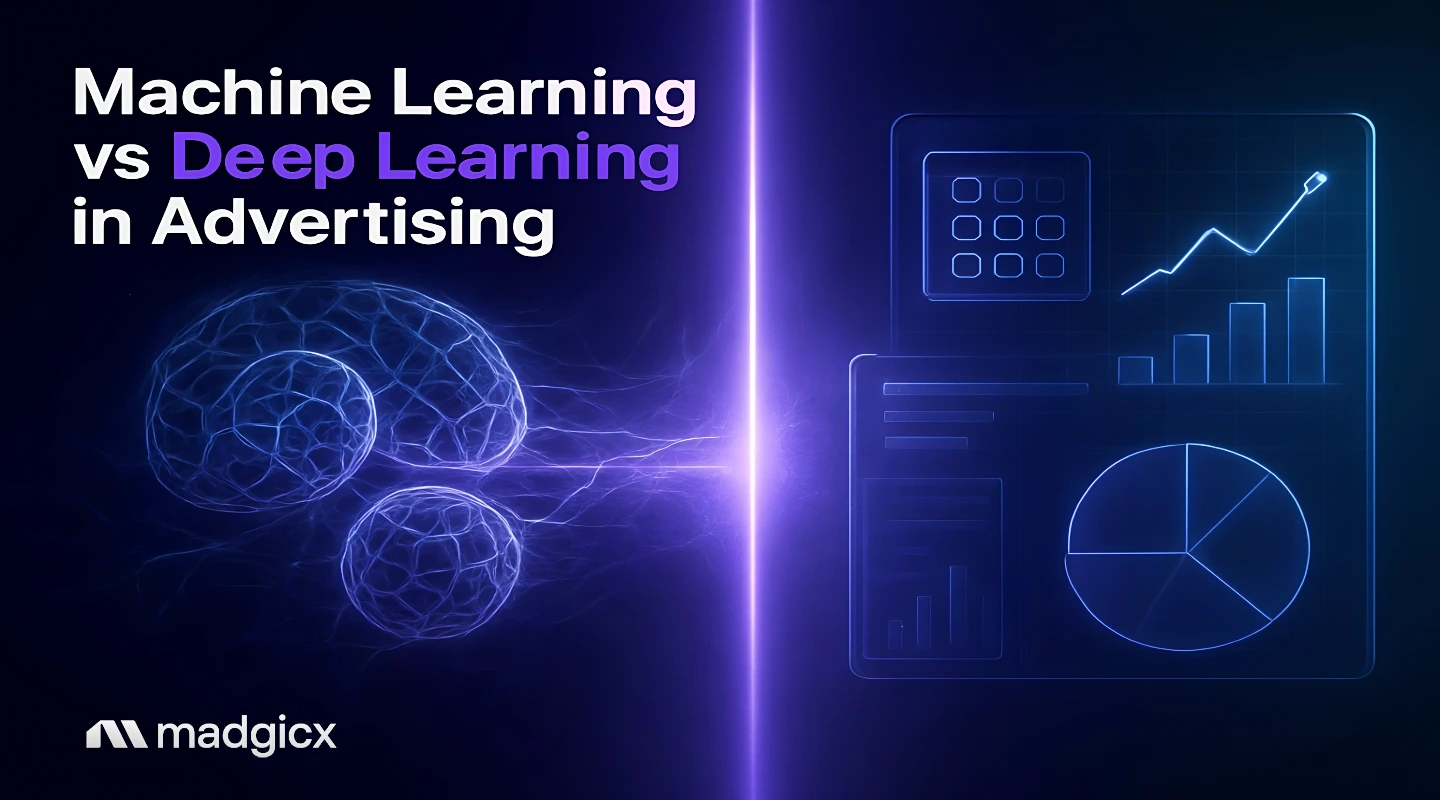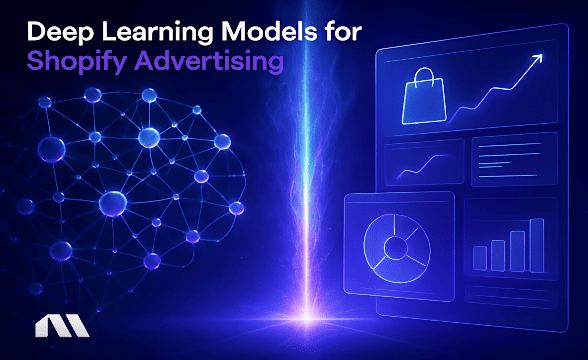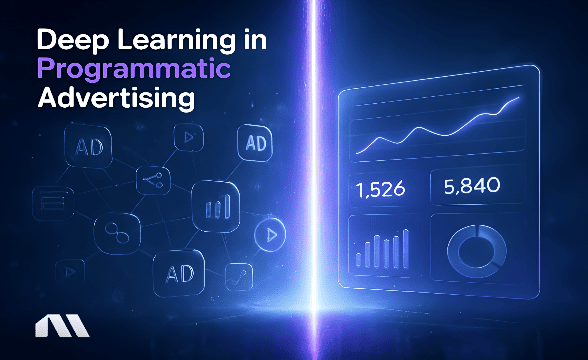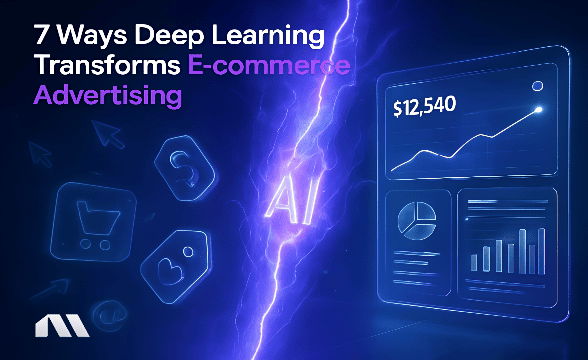Discover machine learning vs deep learning in advertising technology. Learn strategies and get performance benchmarks for AI-powered campaign optimization.
Picture this: You're staring at your campaign dashboard at 2 AM, manually adjusting bids while your competitors' AI systems are optimizing in real-time while they sleep. Sound familiar?
Here's the thing – the advertising world has split into two camps: those leveraging artificial intelligence to scale their performance, and those still fighting the uphill battle with manual optimization. The gap is widening fast, and the numbers don't lie.
Machine learning in advertising uses algorithms to analyze campaign data and automate optimization of bids, budgets, and targeting. Deep learning, a subset of ML, uses neural networks to process complex unstructured data like images and text for advanced personalization and creative optimization, delivering higher ROAS and lower CAC.
The AI advertising market has exploded from $8.2 billion to a projected $37.6 billion by 2033, representing an 18.2% compound annual growth rate. That's not just growth – that's a complete industry transformation happening right now.
But here's what most performance marketers miss: understanding the practical difference between machine learning and deep learning isn't just academic knowledge. It's the key to choosing the right tools, implementing the right strategies, and actually seeing those performance improvements everyone talks about.
What You'll Learn in This Guide
We're going beyond the theory here. You'll walk away with:
- The practical differences between ML and DL for advertising optimization (and when to use each)
- Step-by-step implementation strategies for Meta, Google, and programmatic platforms
- Real performance benchmarks: 14% higher conversion rates and 52% lower customer acquisition costs
- Bonus: A complete ROI calculation framework to measure your AI advertising success
Ready to stop guessing and start scaling? Let's dive in.
Understanding Machine Learning vs Deep Learning in Advertising Technology
Let's cut through the jargon and get to what actually matters for your campaigns.
Machine learning applies statistical algorithms to historical campaign data to predict optimal ad decisions without manual rules. Think of it as your campaign's autopilot – it looks at what worked before and makes educated guesses about what will work next.
Deep learning uses multi-layered neural networks to interpret complex signals like images, text, and behavior for nuanced personalization. This is more like having a creative genius and behavioral psychologist rolled into one, understanding not just what people clicked, but why they clicked.
Here's the hierarchy that matters: Artificial Intelligence is the umbrella, Machine Learning is a subset of AI, and Deep Learning is a subset of ML. In advertising terms:
- AI: The broad concept of machines making smart decisions
- ML: Algorithms that learn from your campaign data to optimize bids, budgets, and targeting
- DL: Neural networks that understand creative elements, user behavior patterns, and complex personalization
For performance marketers, this translates to practical applications. Machine learning handles your optimization heavy lifting – adjusting bids based on conversion probability, reallocating budgets to top-performing ad sets, and identifying your best audiences.
Deep learning takes care of the nuanced stuff – understanding which creative elements drive engagement, personalizing ad experiences, and predicting user lifetime value.
The beauty of modern advertising platforms is that you don't need a PhD to leverage both. Meta's Advantage+ campaigns use machine learning for bidding and budget optimization, while their deep learning models for ad targeting power their audience expansion and lookalike modeling.
Google's Smart Bidding is pure machine learning – it analyzes hundreds of signals to set the perfect bid for each auction. Meanwhile, their Performance Max campaigns layer in deep learning to automatically generate and test creative variations.
Pro Tip: You're probably already using both without realizing it. The question isn't whether to adopt AI – it's how to implement it strategically for maximum impact.
The Performance Impact: What the Data Shows
Enough theory – let's talk numbers that actually matter to your bottom line.
The performance improvements from AI advertising aren't just marketing fluff. According to comprehensive industry analysis, campaigns using AI optimization show 14% higher conversion rates compared to manual management. That's not a marginal improvement – that's the difference between a profitable campaign and a scaling goldmine.
But here's where it gets really interesting: the cost efficiency gains are even more dramatic. AI-optimized campaigns achieve 52% lower customer acquisition costs on average. Think about what that means for your unit economics. If you're currently paying $50 to acquire a customer, AI optimization could potentially bring that down to $24.
The adoption numbers tell the real story. Research shows that 88% of digital marketers now use AI tools daily. This isn't early adopter territory anymore – this is mainstream competitive advantage.
Google's internal data reveals that advertisers see an average $6 return for every $1 spent on AI advertising tools. That's not just ROI – that's substantial growth potential.
Real-world case studies back up these numbers. Reed.co.uk implemented machine learning optimization and saw a 9% lift in conversion rates within the first month. Immobiliare.it took it further with deep learning personalization, achieving a 246% increase in conversion rates.
The market is responding accordingly. The AI advertising sector has grown from $8.2 billion in 2023 to a projected $37.6 billion by 2033, representing that 18.2% compound annual growth rate we mentioned earlier.
But here's what the statistics don't capture: the time savings. Performance marketers report saving 15-20 hours per week on campaign optimization tasks when they implement AI automation properly. That's not just efficiency – that's the difference between being reactive and being strategic.
Pro Tip: The question isn't whether AI advertising works. The data is clear. The question is how quickly you can implement it before your competitors gain an insurmountable competitive advantage.
Machine Learning vs Deep Learning Comparison Framework
Understanding when to use machine learning versus deep learning can make or break your AI advertising strategy. Here's the practical breakdown every performance marketer needs:
Data Requirements
- Machine Learning: Needs structured data (clicks, conversions, demographics, purchase history)
- Deep Learning: Thrives on unstructured data (images, video, text, behavioral patterns)
Primary Use Cases
- Machine Learning: Bid optimization, budget allocation, audience targeting, conversion prediction
- Deep Learning: Creative optimization, personalization, content generation, complex pattern recognition
Implementation Complexity
- Machine Learning: Platform-native tools available (Google Smart Bidding, Meta Advantage+)
- Deep Learning: Often requires custom implementation or specialized platforms
Performance Potential
- Machine Learning: 10-30% improvement in efficiency metrics (CPC, CPM, CTR)
- Deep Learning: 50-200% improvement in engagement and personalization metrics
Cost Considerations
- Machine Learning: Usually included in platform costs, minimal additional investment
- Deep Learning: May require premium tools or custom development, higher initial investment
Time to Results
- Machine Learning: 2-4 weeks for optimization algorithms to learn
- Deep Learning: 4-8 weeks for neural networks to identify complex patterns
For most performance marketers, the strategy is sequential: start with machine learning optimization to handle the fundamentals, then layer in deep learning for advanced personalization and creative optimization.
Machine learning handles the "what" – what bid to set, what budget to allocate, what audience to target. Deep learning handles the "how" – how to personalize the message, how to optimize creative elements, how to predict complex user behaviors.
The platforms are making this easier. Meta's predictive ad optimization combines both approaches seamlessly. Google's Performance Max does the same, using ML for bidding and DL for creative optimization.
Pro Tip: You don't have to choose between them. The most successful campaigns use machine learning as the foundation and deep learning as the enhancement layer.
Platform-Specific Implementation Strategies
Now let's get tactical. Here's how to implement AI optimization across the platforms that actually matter for performance marketing.
Meta Advertising (Advantage+ Implementation)
Meta's Advantage+ campaigns are your gateway to machine learning optimization. Here's the step-by-step approach that actually works:
Campaign Structure Setup:
Start with Advantage+ Shopping campaigns if you're e-commerce, or Advantage+ App campaigns for app marketers. The key is giving the algorithm maximum flexibility. Use broad targeting – resist the urge to narrow down to your "perfect" audience. The machine learning needs room to explore and optimize.
Bidding Strategy:
Implement value-based bidding from day one. Upload your customer lifetime value data or at least your average order values. The algorithm optimizes better when it understands the true value of each conversion, not just the quantity.
Creative Testing Integration:
This is where deep learning shines. Use Madgicx's AI Ad Generator to create multiple creative variations, then let Meta's algorithm test and optimize. The combination of AI-generated creatives with Meta's machine learning optimization creates a powerful testing engine.
Budget Allocation:
Enable Advantage Campaign Budget and start with at least $50/day per campaign. The algorithm needs sufficient budget to make meaningful optimization decisions. Manual budget adjustments should be minimal – let the machine learning handle the allocation.
Google Ads (Smart Bidding + Performance Max)
Google's AI tools are more mature but require different implementation strategies:
Smart Bidding Setup:
Choose Target ROAS for e-commerce or Target CPA for lead generation. The key is setting realistic targets based on historical performance. Start 20% less aggressive than your manual targets to give the algorithm learning room.
Performance Max Campaign Structure:
Upload high-quality assets across all formats – images, videos, headlines, descriptions. The deep learning algorithms need variety to optimize effectively. Include your best-performing manual campaign assets as a starting point.
Broad Match Implementation:
This is where most marketers mess up. Broad match keywords with Smart Bidding are incredibly powerful, but you need proper negative keyword management and conversion tracking. The deep learning models can identify relevant search intent you'd never find manually.
Programmatic Platforms (RTB House, Criteo)
For advanced performance marketers ready to scale beyond social media and search:
Deep Learning Retargeting:
Platforms like RTB House use deep learning to analyze user behavior patterns and predict purchase intent. The setup requires pixel implementation and product feed optimization, but the personalization capabilities are unmatched.
Real-Time Personalization:
Criteo's engine personalizes ad creative in real-time based on browsing behavior, purchase history, and contextual signals. This requires dynamic creative templates and comprehensive product catalogs.
Cross-Platform Attribution:
Advanced programmatic platforms use machine learning to attribute conversions across touchpoints. This is crucial for understanding the true impact of your AI advertising investments.
The implementation pattern is consistent across platforms: start with platform-native AI tools, ensure proper data foundation, allow sufficient learning periods, and gradually increase sophistication.
Step-by-Step Getting Started Guide
Ready to implement? Here's your practical roadmap to AI advertising success:
Step 1: Audit Your Current Data Quality and Volume
Before any AI implementation, assess what you're working with. You need at least 50 conversions per week for machine learning algorithms to optimize effectively. Check your conversion tracking setup – AI is only as good as the data it receives.
Ensure your Facebook Pixel, Google Analytics, and any other tracking systems are firing correctly. Use Facebook's Test Events tool and Google's Tag Assistant to verify proper implementation.
Step 2: Choose Platform-Native AI Tools Based on Your Primary Channel
Don't try to boil the ocean. If Meta drives 70% of your revenue, start with Advantage+ campaigns. If Google is your primary channel, begin with Smart Bidding. The platform-native tools are free, well-supported, and integrate seamlessly with your existing campaigns.
Step 3: Set Up Conversion Tracking and Value-Based Bidding
This is non-negotiable. Upload your customer lifetime values, average order values, or lead values. The algorithms optimize for what you measure, so make sure you're measuring what matters. Implement server-side tracking if you're dealing with iOS attribution challenges – Madgicx includes this automatically.
Step 4: Implement Broad Match with Smart Bidding for ML Optimization
Resist the urge to micro-manage. Broad targeting with machine learning optimization consistently outperforms narrow targeting with manual optimization. Start with broad demographics, interests, and keywords, then let the algorithms find your best audiences.
Step 5: Allow 2-4 Week Learning Period Without Manual Intervention
This is where most marketers fail. The algorithms need time to gather data and optimize. Avoid the temptation to make daily adjustments. Monitor performance, but don't interfere unless you see catastrophic issues. The custom deep learning models need consistent data to identify patterns.
Step 6: Monitor Performance and Provide Ongoing Signal Optimization
After the learning period, focus on signal quality, not campaign tweaks. Add more conversion events, improve your landing pages, and upload better creative assets. The AI will optimize the campaigns – your job is to feed it better data.
Step 7: Scale Successful AI Campaigns Gradually with Budget Increases
Once you see consistent performance improvements, scale gradually. Increase budgets by 20-50% weekly rather than doubling overnight. Sudden budget changes can disrupt the learning algorithms and reset optimization progress.
Pro Tip: AI advertising success comes from strategic patience, not tactical impatience. Set up the foundation correctly, then let the algorithms do what they do best.
ROI Measurement Framework
Here's how to actually measure whether your AI advertising investments are paying off:
Baseline Performance Establishment
Before implementing any AI tools, document your current performance metrics. Track not just ROAS and CPA, but also time spent on optimization, campaign setup time, and creative production costs. AI's value includes efficiency gains, not just performance improvements.
AI Implementation Cost Calculation
Factor in platform fees, tool subscriptions, and setup time. Madgicx's AI Marketer costs less than hiring a junior Meta ads media buyer, but provides expert-level optimization 24/7. Calculate the true cost, including the opportunity cost of manual optimization time.
Performance Improvement Tracking
Monitor leading indicators (CTR, engagement rates) and lagging indicators (conversions, revenue). AI typically improves leading indicators first, with revenue improvements following 2-4 weeks later. Track performance by cohorts – AI-optimized campaigns versus manual campaigns.
Long-Term Value Assessment
The real ROI comes from compound improvements over time. AI algorithms get smarter with more data, so performance improvements accelerate. Track quarterly performance trends, not just monthly snapshots.
Madgicx ROI Tracking Examples
Our platform provides automated ROI reporting that factors in time savings, performance improvements, and cost efficiencies. Typical customers see 3-5x ROI within 90 days when accounting for both performance gains and operational efficiency.
Pro Tip: The framework is simple: measure everything before implementation, track improvements systematically, and calculate total value including time savings and efficiency gains.
Advanced Applications and Future Trends
The AI advertising landscape is evolving rapidly. Here's what's coming next and how to prepare:
Creative Optimization with Deep Learning
AI-generated creative is moving beyond simple image generation. Advanced platforms now optimize video content, generate personalized ad copy, and even create interactive ad experiences. The future is dynamic creative that adapts in real-time to user behavior and context.
Predictive Audience Modeling
Machine learning is shifting from reactive optimization to predictive modeling. Instead of optimizing based on past performance, algorithms now predict future user behavior and optimize proactively. This enables campaign strategies that anticipate market changes rather than react to them.
Cross-Platform Attribution
Deep learning models are solving the attribution puzzle by analyzing user journeys across devices, platforms, and touchpoints. This enables true unified optimization across your entire marketing ecosystem, not just individual platform optimization.
Privacy-Compliant AI Strategies
As privacy regulations tighten, AI becomes more important, not less. Deep learning enables effective targeting without relying on third-party cookies or invasive tracking methods.
2025 Developments and Roadmap
Expect AI advertising to become more sophisticated, more creative, and more integrated. The platforms are moving toward highly automated campaign management with strategic human oversight rather than human management with AI assistance.
Pro Tip: Stay ahead of the curve while focusing on fundamentals. Master current AI tools before chasing the latest developments.
Frequently Asked Questions
What's the minimum budget needed for AI advertising?
Most platforms require at least $50/day for machine learning algorithms to optimize effectively. However, you can start testing with smaller budgets – just expect longer learning periods. Google Smart Bidding works with budgets as low as $20/day, while Meta Advantage+ performs best with $100+ daily budgets.
The key is having enough volume for the algorithms to make statistically significant optimizations.
How long before AI campaigns show results?
Expect 2-4 weeks for initial optimization and 6-8 weeks for full performance potential. Machine learning algorithms need time to gather data and identify patterns. Don't judge performance in the first week – the algorithms are still learning.
Most successful AI campaigns show meaningful improvements by week 3 and reach peak performance by week 6.
Can AI replace human creative strategy?
AI excels at optimization, testing, and personalization, but human creativity remains essential for breakthrough campaigns and brand strategy. The winning approach combines AI efficiency with human creativity. Use AI for testing and optimization, humans for strategy and brand positioning.
Madgicx's AI Ad Generator creates effective ads, but your brand voice and positioning still require human input.
How do I know if AI is actually improving performance?
Compare AI-optimized campaigns against manual campaigns using the same targeting and creative. Track both efficiency metrics (CPC, CPM) and effectiveness metrics (conversion rates, ROAS). Most importantly, measure total account performance, not just individual campaign performance.
AI often improves overall efficiency even if individual campaigns show mixed results.
What data do I need for machine learning to work?
At minimum, you need accurate conversion tracking and at least 50 conversions per week. For optimal performance, include customer lifetime values, product margins, and seasonal patterns. The more signal you provide, the better the optimization.
Quality matters more than quantity – clean, accurate data beats large volumes of messy data every time.
Start Your AI Advertising Journey Today
The numbers don't lie: AI advertising delivers 14% higher conversion rates, 52% lower customer acquisition costs, and saves 15-20 hours of manual optimization time per week. The question isn't whether to adopt AI – it's how quickly you can implement it effectively.
Start with platform-native tools before investing in custom solutions. Meta's Advantage+ campaigns and Google's Smart Bidding provide immediate access to machine learning optimization without additional costs. Layer in deep learning tools like Madgicx's AI Ad Generator for creative optimization and AI Marketer for comprehensive campaign management.
The AI advertising revolution isn't coming – it's here. Madgicx combines both ML optimization and DL creative generation in one platform, providing the comprehensive Meta ads AI solution that performance marketers need to stay competitive.
Remember: start small, test thoroughly, and scale what works. The algorithms get smarter with more data, so the sooner you start, the bigger your competitive advantage becomes.
The future belongs to marketers who embrace AI as a strategic advantage, not just a tactical tool. Your competitors are already implementing these strategies – the question is whether you'll lead or follow.
Madgicx's AI Marketer combines machine learning bidding, deep learning creative optimization, and intelligent budget allocation to maximize your Meta advertising ROI. Join thousands of performance marketers scaling with AI automation.
Digital copywriter with a passion for sculpting words that resonate in a digital age.







.avif)







